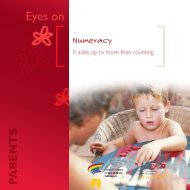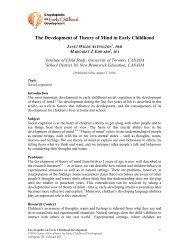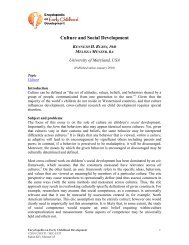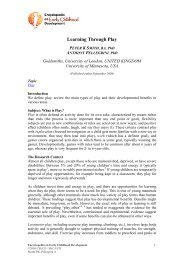Eyes on Physical activity and young children - Encyclopedia on ...
Eyes on Physical activity and young children - Encyclopedia on ...
Eyes on Physical activity and young children - Encyclopedia on ...
You also want an ePaper? Increase the reach of your titles
YUMPU automatically turns print PDFs into web optimized ePapers that Google loves.
<str<strong>on</strong>g>Eyes</str<strong>on</strong>g> <strong>on</strong><br />
<strong>Physical</strong> <strong>activity</strong><br />
<strong>and</strong> <strong>young</strong> <strong>children</strong><br />
A fun <strong>and</strong> healthy habit
<strong>Physical</strong> <strong>activity</strong> <strong>and</strong> <strong>young</strong> <strong>children</strong><br />
“The first few years of life are<br />
the best time for you to help<br />
your child develop a positive<br />
attitude to healthy eating <strong>and</strong><br />
active living. He’ll carry this<br />
attitude to his later years.”<br />
Melanie Ferris,<br />
Huntinghawk Communicati<strong>on</strong>s<br />
Excerpted from: Best Start<br />
Resource Centre (2010). Let’s Be<br />
Healthy Together: Getting active.<br />
Tor<strong>on</strong>to: Health Nexus.<br />
© 2011 – Centre of Excellence for Early Childhood Development<br />
What do we know?<br />
n <strong>Physical</strong> <strong>activity</strong> is a part of your child’s daily routine. Playing ball, running, <strong>and</strong><br />
dancing are all vigorous activities. Children are active even when st<strong>and</strong>ing <strong>and</strong><br />
drumming or walking exploring Mother Earth, but are not when they sit or lie down<br />
to watch TV, play video games, read or draw.<br />
n The early years represent the perfect time to introduce physical <strong>activity</strong> as a life-l<strong>on</strong>g<br />
healthy habit.<br />
n <strong>Physical</strong> <strong>activity</strong> has positive effects <strong>on</strong> your child health, including your child’s body,<br />
mind, spirit, <strong>and</strong> emoti<strong>on</strong>s. In the l<strong>on</strong>g term, it can also keep your child from developing<br />
health problems (like cardiovascular diseases), <strong>and</strong> promote healthy b<strong>on</strong>es, good motor<br />
skills, <strong>and</strong> good social <strong>and</strong> emoti<strong>on</strong>al development.<br />
n Young <strong>children</strong> who are physically active <strong>on</strong> a daily basis are more likely to maintain a<br />
healthy weight.<br />
n Many <strong>young</strong> <strong>children</strong> do not take part in enough physical <strong>activity</strong> to stay healthy.<br />
n Children are more active when their parents, extended family, <strong>and</strong> communities have<br />
an active lifestyle <strong>and</strong> take part in physical <strong>activity</strong> with them.<br />
n Boys are more active than girls.<br />
n The more <strong>children</strong> play outside, the more physically active they are likely to be.<br />
n When <strong>young</strong> <strong>children</strong> are inactive (for example, watching televisi<strong>on</strong>), they are at risk<br />
for developing health issues, including weight problems. Preschool <strong>children</strong> who watch<br />
more than 2 hours of televisi<strong>on</strong> a day are more likely than others to experience health<br />
<strong>and</strong> developmental problems.<br />
n There is no evidence that using electr<strong>on</strong>ic media can benefit your child’s health or<br />
educati<strong>on</strong> under the age of 2. In fact, in <strong>children</strong> who watch a lot of televisi<strong>on</strong> in these<br />
first few years, it has been shown that:<br />
– They are likely to experience problems with their attenti<strong>on</strong> span later <strong>on</strong>;<br />
– They are at risk for developing language <strong>and</strong> memory difficulties;<br />
– They tend to experience more difficulties in school than <strong>children</strong> who do not watch<br />
a lot of televisi<strong>on</strong>.<br />
n For <strong>children</strong> who attend child care facilities <strong>on</strong> a regular basis, the setting can play a<br />
crucial role in ensuring that they get the amount of physical <strong>activity</strong> they need.
Paying attenti<strong>on</strong> to... What can you do?<br />
... your child’s participati<strong>on</strong> in physical<br />
activities.<br />
... l<strong>on</strong>g periods of in<strong>activity</strong>.<br />
... the time spent using televisi<strong>on</strong> <strong>and</strong><br />
electr<strong>on</strong>ic media.<br />
... be a role model for your child.<br />
... the child care envir<strong>on</strong>ment.<br />
A fun <strong>and</strong> healthy habit<br />
n Provide unstructured <strong>and</strong> structured activities that your child can<br />
take part in <strong>and</strong> enjoy (walk, garden, play ball, climb in a jungle<br />
gym, bike).<br />
n If your child can walk, allow him to be active for at least 3 hours<br />
a day.<br />
n Emphasize fun <strong>and</strong> participati<strong>on</strong> rather than competiti<strong>on</strong>, <strong>and</strong> be<br />
a play partner for your child. Some things you can do as a family<br />
include jigging, growing a garden, or learning to dance in a pow<br />
wow.<br />
n Encourage your child to spend time outdoors, ideally several<br />
hours every day.<br />
n Make sure your daughter <strong>and</strong> your s<strong>on</strong> are equally active.<br />
n Arrange a play partner for your child to motivate him to be<br />
active.<br />
n Take care that your child is not inactive for more than <strong>on</strong>e hour<br />
at a time (except for sleeping).<br />
n Divide l<strong>on</strong>g motorized trips by 10 to 15 minute energizing breaks.<br />
n Whenever possible, encourage your child to walk rather than sit<br />
in a stroller or be carried <strong>on</strong> your back.<br />
n Ban televisi<strong>on</strong>s <strong>and</strong> game c<strong>on</strong>soles from your child’s bedroom<br />
<strong>and</strong>, if possible, from the child-care centre.<br />
n Discourage the use of televisi<strong>on</strong> <strong>and</strong> electr<strong>on</strong>ic media with<br />
<strong>children</strong> under 2, <strong>and</strong> limit it to 1 hour a day for <strong>children</strong><br />
between 2 <strong>and</strong> 5.<br />
n Be active <strong>and</strong> have fun with your child with activities such as<br />
gardening, gathering berries, bike riding, <strong>and</strong> exploring your<br />
traditi<strong>on</strong>al l<strong>and</strong>s.<br />
n Look for a setting that has enough outdoor space, equipment,<br />
<strong>and</strong> shaded areas.<br />
n Choose a safe <strong>and</strong> secure envir<strong>on</strong>ment where staff promotes<br />
physical <strong>activity</strong> for <strong>young</strong> <strong>children</strong>.<br />
© 2011 – Centre of Excellence for Early Childhood Development
Coordinator:<br />
Nathalie Moragues<br />
Advisory Committee:<br />
D<strong>on</strong>na Atkins<strong>on</strong> (NCCAH)<br />
Julie Bernier (FNQLHSSC)<br />
Melanie Ferris (Huntinghawk Communicati<strong>on</strong>s)<br />
Christine Lamothe (Government of Nunavut)<br />
Annie Nulukie (KRG)<br />
Nadine Rousselot (FNQLHSSC)<br />
Collaborators:<br />
Claire Gasc<strong>on</strong> Giard<br />
Marie-Pierre Gosselin<br />
Copy editors:<br />
Valérie Bell<br />
S<strong>and</strong>ra Braun<br />
Photos:<br />
Fred Cottroll (p. 2)<br />
Jennifer F<strong>on</strong>taine (p. 1 <strong>and</strong> 4)<br />
Informati<strong>on</strong><br />
This Key Message is a publicati<strong>on</strong> of the Centre of Excellence for Early Childhood<br />
Development (CEECD) <strong>and</strong> the Strategic Knowledge Cluster <strong>on</strong> Early Child<br />
Development (SKC-ECD). These organizati<strong>on</strong>s identify <strong>and</strong> summarize the best<br />
scientific work <strong>on</strong> early childhood development. They disseminate this knowledge<br />
to a variety of audiences in formats <strong>and</strong> languages adapted to their needs.<br />
For a more in-depth underst<strong>and</strong>ing of physical <strong>activity</strong>, c<strong>on</strong>sult the synthesis <strong>and</strong><br />
experts’ articles <strong>on</strong> this topic in the <strong>Encyclopedia</strong> <strong>on</strong> Early Childhood Development,<br />
available free of charge at www.child-encyclopedia.com.<br />
Several funders financially support the CEECD <strong>and</strong> the SKC-ECD, including the Social<br />
Sciences <strong>and</strong> Humanities Research Council of Canada, Université Laval, <strong>and</strong> private<br />
foundati<strong>on</strong>s. The views expressed herein do not necessarily represent the official<br />
policies of these organizati<strong>on</strong>s.<br />
We are grateful to The Laws<strong>on</strong> Foundati<strong>on</strong> for its financial c<strong>on</strong>tributi<strong>on</strong> to produce<br />
this Key Message.<br />
Centre of Excellence for Early Childhood Development<br />
GRIP-Université de M<strong>on</strong>tréal<br />
P.O. Box 6128, Succursale Centre-ville<br />
M<strong>on</strong>treal, Quebec H3C 3J7<br />
Teleph<strong>on</strong>e: 514.343.6111, extensi<strong>on</strong> 2541<br />
Fax: 514.343.6962<br />
E-mail: cedje-ceecd@um<strong>on</strong>treal.ca<br />
Website: www.excellence-earlychildhood.ca<br />
Graphic design:<br />
DesJardins C<strong>on</strong>cepti<strong>on</strong> Graphique inc. In this document, the masculine form is used to simplify the text. No discriminati<strong>on</strong> is intended.








